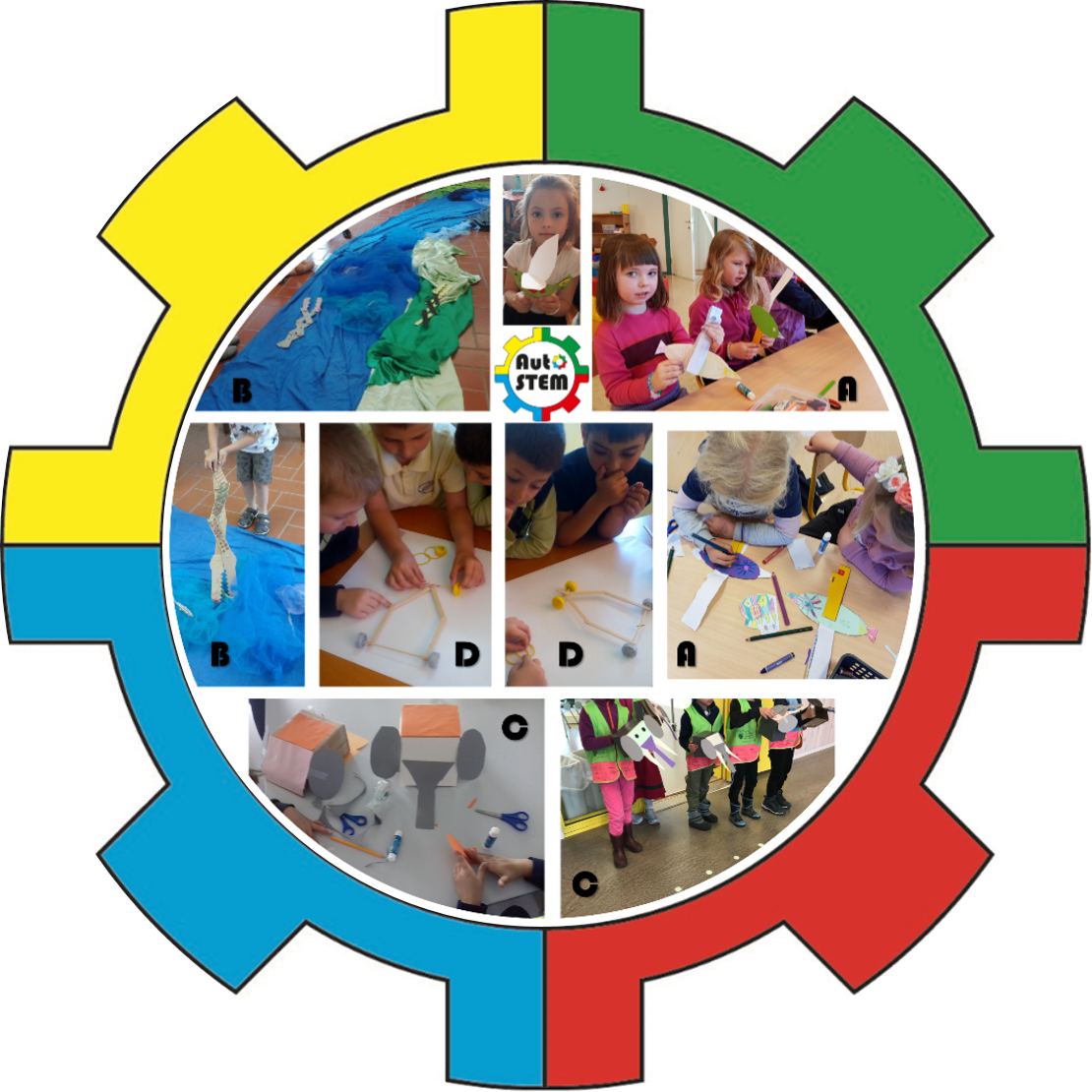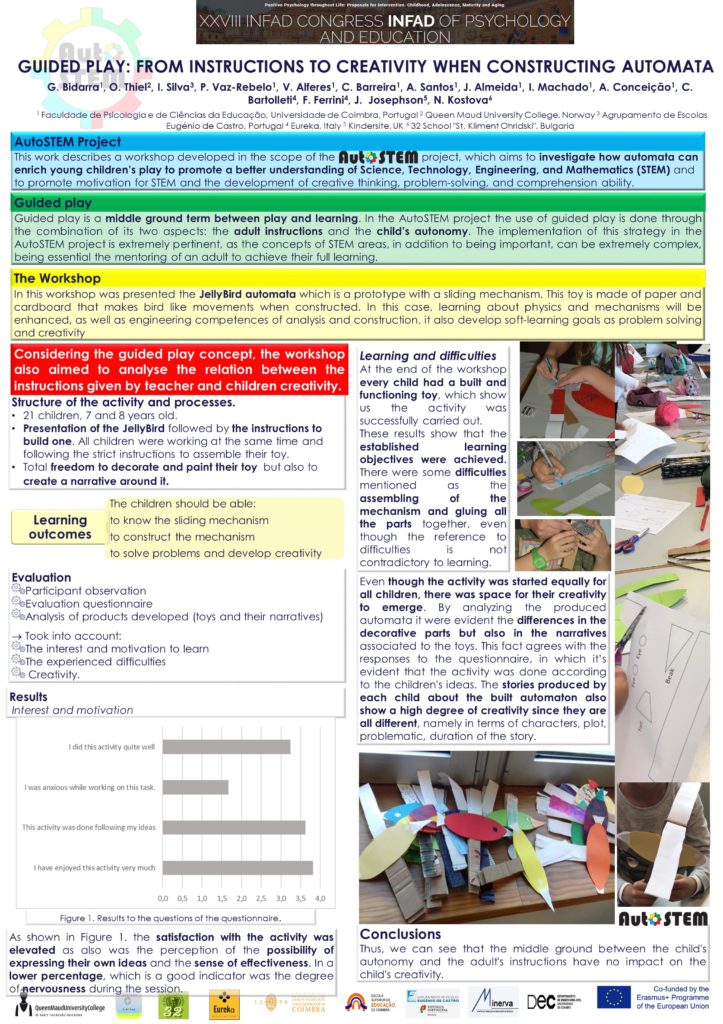Introduction
This section focuses on teaching processes used in the AutoSTEM project, in particular, play-based pedagogy and guided play, as well as how they can be considered in children automata construction workshops.
- What is play and why is it important?
- What is the teacher’s role?
- How can automata be used to promote play and learning?
The following tasks and resources will guide you to explore what are play-based pedagogy and guided play and how they may be implemented in the scope of the AutoSTEM project.
Learning outcomes
In this module, you will learn
- to characterise play-based pedagogy,
- to analyse the role of play in children’s development,
- to characterise guided play and the role of the teacher,
- to understand the different roles of the teacher when using automata,
- to reflect on competences that can be promoted when constructing automata.
Play
Play has been considered an essential activity for children cognitive, social, emotional development. Pedagogues, educators, educational psychologist have been stressing the importance of play in children development. According to Friedrich Fröbel (1887, p. 57), play is ‘the highest expression of human development in childhood, for it alone is the free expression of what is in a child’s soul.’ Lev Vygotsky (1978, p. 102) also supported this view by stating, ‘In play, a child always behaves beyond his average age, above his daily behaviour’ and ‘play always leads to a more advanced level of development. In the same sense, Piaget (1969) and Bruner (1960) emphasise the importance of acting and discovery on the cognitive development. Bruner (1960) highlights the role of systematic interactions between educator and child.
Nowadays the benefits of playing in learning are already known, although these two principles are still often presented dichotomously. To respond to this opposition, the guided-play concept emerges as a middle term between both principles. The guided-play concerns “learning experiences that combine the child-directed nature of free play with a focus on learning outcomes and adult mentorship” (Weisberg, Hirsh-Pasek, Golinkoff, Kittredge & Klahr, 2016, p.177). It has been shown that guided play helps children to a better understanding of academic concepts than direct instruction (Han et al., 2010; Stipek et al., 1995) or free play alone (Chien et al., 2010; Honomichl & Chen, 2012).
Guided play
- How can you implement guided play in educational settings?
- Which role do teachers and children have in guided play?
- How can guided play be implemented when using automata for motivating STEM teaching?
In order to learn more about guided play and how it was implemented during the AutoSTEM project, you can watch the following video on Guided Play and read the case study ‘From guided play to creativity: Metamorphoses and stories of a bird‘.
Case study From guided play to creativity: Metamorphoses and stories of a bird
This case study describes a workshop developed in the scope of the AutoSTEM project, designed to investigate how automata can enrich young children’s play to promote a better understanding of and motivation for STEM and creative thinking. The workshop also aimed to analyse the relation between teacher guidance and children’s creativity during the activity.
The case study is published in the International Journal of Developmental and Educational Psychology as
Bidarra, G., Vaz Rebelo, P., Thiel, O., Alferes, V., Silva, I., Barreira, C., Santos, A., Almeida, J., Machado, I., Conceiçao, A., Bartolleti, C., Ferrini, F., Josephson, J., & Kostova, N. (2020). Guided play: from instructions to creativity when constructing automata. International Journal of Developmental and Educational Psychology, 2(1), 221-228. doi:https://doi.org/10.17060/ijodaep.2020.n1.v2.1832
Reflection
Watch the following videos from AutoSTEM workshops and reflect on the displayed teaching and learning processes by answering the following questions:
- What did the children?
- What did the educators/ teachers?
- How do you describe the role of the educators/teachers?
- What did the children learn about STEM during these activities?
Learn more about Bruner’s theory of cognitive development
Other projects using a play-based pedagogy
Quiz
References
Bruner, J. 1960. The Process of Education. Cambridge: Harvard University Press.
Chien, N. C., Howes, C., Burchinal, M., Pianta, R. C., Ritchie, S., Bryant, D. M., Clifford, R. M., Early, D. E. & Barbarin, O. A. (2010). Children’s classroom engagement and school readiness gains in prekindergarten. Child Development, 81(5), 1534-1549. DOI:10.1111/j.1467-8624.2010.01490.x.
Fröbel, F. W. (1887). The Education of Man. New York: Appleton.
Han, M., Moore, N., Vukelich, C., & Buell, M. (2010). Does play make a difference? Effects of play intervention on at-risk preschoolers’ vocabulary learning. American Journal of Play, 3(1), 82-105.
Honomichl, R. D. & Chen, Z. (2012). The role of guidance in children’s discovery learning. Wiley Interdisciplinary Reviews: Cognitive Science, 3(6), 615-622. doi:10.1002/wcs.1199.
Piaget, J. & Inhelder, B. 1969. The Psychology of the Child. London: Routledge & Kegan Paul.
Stipek, D., Feiler, R., Daniels, D. & Milburn, S. (1995). Effects of different instructional approaches on young children’s achievement and motivation. Child Development, 66(1), 209-223. DOI:10.2307/1131201.
Vygotsky, L. S. (1978). Mind in Society. The Development of Higher Psychological Processes. Edited by M. Cole. Cambridge: Harvard University Press.
Weisberg, D. S., Hirsh-Pasek, K., Golinkoff, R. M., Kittredge, A. K. & Klahr, D. (2016). Guided Play: Principles and Practices. Current Directions in Psychological Science, 25(3), 177-182. DOI: 10.1177/0963721416645512.




